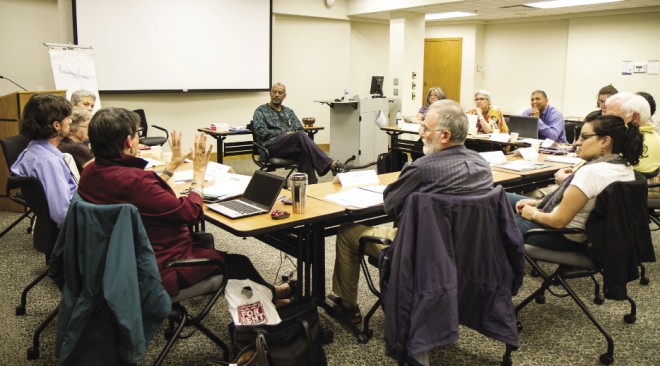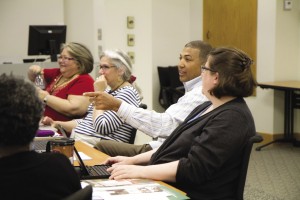Traumagenic. Don’t know the word? It’s a new adjective found throughout the manual Transforming Historical Harms by David Anderson Hooker and Amy Potter Czajkowski.
Traumagenic refers to events or circumstances – like colonization, civil war, slavery, genocide, systemic discrimination – that cause traumatic reactions and impacts, typically embodied in generation after generation. The victims (and their descendants) of such trauma obviously carry wounds, but so do the perpetrators, though these roles may shift over time, with changing circumstances. Think of the Hutus and the Tutsis of Rwanda and Burundi – at different times each group has been among the victims and each among the perpetrators of violence.
“Historically traumagenic circumstances that have not been healed, reconciled or made right can have continuing consequences at the individual, family, organizational, communal, regional, national and even international level for generations,” write Hooker and Czajkowski in Transforming Historical Harms, published in 2011 by EMU’s Center for Justice and Peacebuilding.
The authors emphasize that the mere passage of time does not heal trauma. For this reason, EMU’s STAR program offers trainings centered on the teachings in the Transforming Historical Harms (THH) manual.
“The THH framework requires an understanding of trauma, historical trauma and harms, the mechanisms of legacy and aftermath, and finally a holistic healing approach that’s inclusive of these understandings,” explain Hooker and Czajkowski.
The “healing approach” is grounded in these values:
- truth, based on understanding and facing what really happened in the past;
- mercy, based on developing an empathy for the “other” in his or her context;
- justice, based on righting the wrongs of the past by taking corrective steps today;
- peace, based on recognizing each other’s dignity.

Hooker, assisted by STAR director Elaine Zook Barge, led a two-day THH workshop for 11 participants in April 2013 at EMU. In it, Hooker stressed the importance of “narrative,” or listening to each other’s stories, as a key step in the healing process.
As an example, the THH manual cites Fambul Tok in Sierra Leone (fambultok.org), a national movement of reconciliation and healing to address the aftermath of an 11-year civil war in that country. Sparked by John Caulker and Elisabeth Hoffman, Fambul Tok spread through villages and the countryside, with circles of neighbors sitting around bonfires sharing their experiences, including many instances of confessions, apologies, and forgiveness. At the end, cleansing ceremonies were held.
In the United States, Hooker pointed out that racism remains prevalent through various belief systems and social structures that can trace their roots back to slavery and other events and institutions that many people would consider bygones.

One specific example that came up at the April training was how the federal Home Owners’ Loan Corporation, or HOLC, assessed property values in hundreds of American cities in an attempt to mitigate a foreclosure crisis during the Great Depression. In Richmond, Virginia, the HOLC assigned grades of A, B, C or D to rank neighborhoods from high (A) to low (D) in terms of desirability and property value. Reflecting the prejudices of the time, race figured into the HOLC assessors’ work in a way shocking to any sensibility today: every neighborhood where African-Americans lived got a D regardless of other factors. Every white neighborhood was given an A, a B or a C, and proximity to “negro” areas was sometimes listed as a reason why a white neighborhood received a lower assessment than facts would otherwise dictate.
That was in 1937, and it would be unthinkable today for an agency of the federal government to engage in such blatant racism. Even so, the effects of those 75-year-old policies continue to inflict pain in Richmond.
“The areas that were ‘Ds’ are impoverished neighborhoods now, and thedy were not necessarily that at the time [they were assessed],” says workshop participant Cricket White, national director of training and project development for the Richmond nonprofit Hope in the Cities.
The HOLC assessments directly affected property owners’ access to credit and depressed home values in low-rated neighborhoods. Before long, well-to-do people of any race who lived in D neighborhoods left. Poorer ones stayed, concentrating poverty in specific areas. In ensuing decades, policy-makers picked these exact neighborhoods for public housing redevelopment. Today, residents in these neighborhoods face the full gamut of trauma-causing structural problems that plague the urban poor in America: limited access to education, transportation, jobs, healthy food at market prices, and other basic components of comfort, security and dignity.
Another aspect of historic trauma addressed in the THH training is the role of “legacy,” or beliefs and biases in perpetuating trauma rooted in the past. In the case of the HOLC neighborhood assessments in Richmond, an example of this legacy would be modern-day explanations for the poverty that persists in the neighborhoods assigned a “D” rating decades earlier: laziness, irresponsibility, self-destructive choices, and residents’ other personal shortcomings. Using the THH approach, these explanations are seen to be focused on the symptoms of a social illness – a modern injustice – that began with a past harm inflicted by racist policies.
“Even if we are ‘past’ it in terms of policy, we’re not past it in terms of attitudes that people have passed on,” says White.
Identifying, understanding and changing the persisting legacy of trauma-causing events in the past is “the heart of transforming historical harms’ work,” says Hooker, who has been affiliated with CJP for a decade and regularly teaches at the Summer Peacebuilding Institute. “Everything else is form and function behind that.”
The THH manual by Hooker and Czajkowski was originally prepared for Coming to the Table, a program developed at EMU that adapted the STAR model to address the specific historical trauma of slavery in America. (Czajkowski now works with the Women’s Peacebuilding Leadership Program at EMU.) The two undertook the project as it became clear that the historic trauma-healing framework developed at Coming to the Table had wide applicability to other historic traumas in other settings. 1
At the April workshop, Hooker encouraged each individual participant to imagine specific steps to begin healing the ongoing traumas connected to their lives.
In Richmond, White and her organization have begun to address the legacy of the HOLC neighborhood assessments by creating a PowerPoint presentation to publicize resources available to address specific problems – e.g., access to transportation – that persist today.
The April training at EMU, attended by nearly a dozen people with varying professional and personal interests in the subject, was one of the first official THH trainings offered through the STAR program. Hooker has also been using the methodology for the past three years in Greensboro, North Carolina, where he is part of an effort to address the city’s history of racism.
Karen B. Froming, assistant clinical professor in psychiatry at the University of California in San Francisco, wrote in a follow-up email to Hooker and Barge, “I have found the material to be haunting me as I think about all the ways in which historical harms operate in our lives. While I may do work in Rwanda, it is quite apparent how much work we have to do in this country.”
Several participants said the opportunity to spend two days with other people who share an interest in the understanding and healing of historical trauma provided encouragement.
“It feels good to know you’re not alone doing this stuff,” says Iris de León-Hartshorn, director for transformative peacemaking of Mennonite Church USA. De León-Hartshorn is involved in addressing historical traumas related to boarding and mission schools – including several run by the Mennonite church – where Native American children were sent for assimilation into white American culture.
1. Coming to the Table continues its work confronting the legacy of slavery as an “associate organization” to EMU’s Center for Justice and Peacebuilding, while the STAR program has begun periodically offering the more general Transforming Historic Harms training.